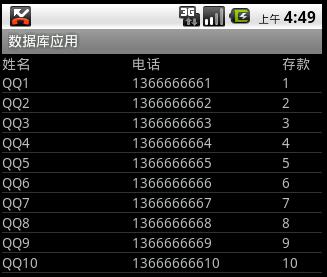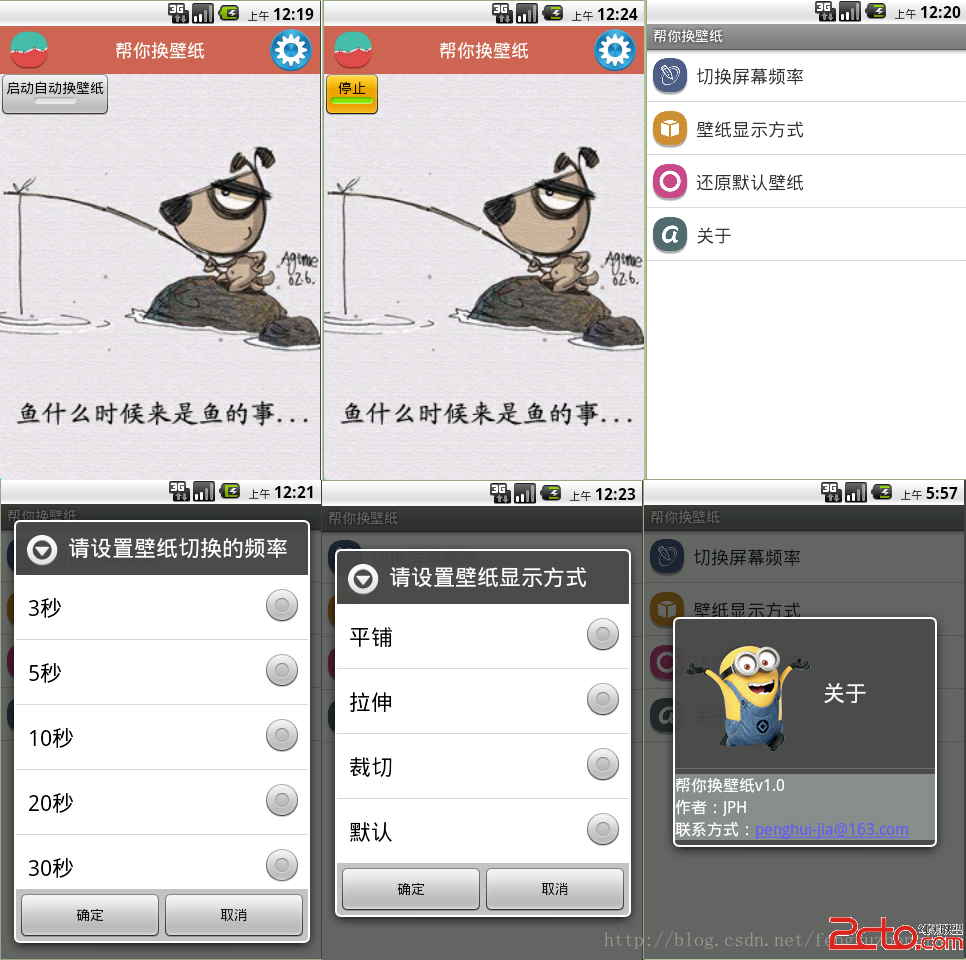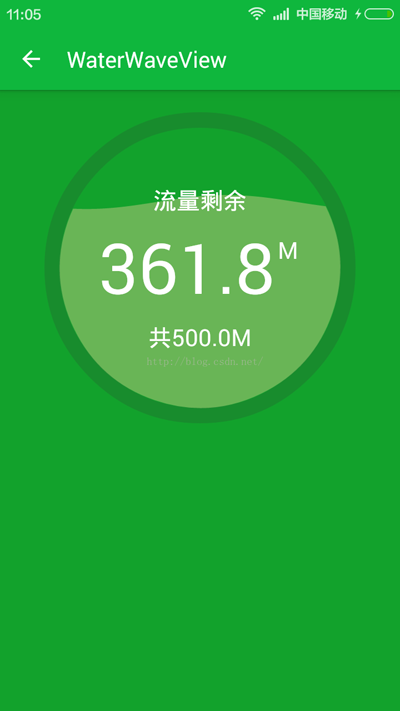編輯:關於Android編程
本文實例講述了Android編程使用ListView實現數據列表顯示的方法。分享給大家供大家參考,具體如下:
要將數據庫中的數據列表顯示在屏幕上,我們要使用ListView這個控件,當用戶從數據庫中取出數據時,要將數據綁定到顯示控件上,如何綁定呢,我們需要創建適配器進行綁定,創建適配器有兩種方式:
第一種是用SimpleAdapter創建(要求綁定的數據是List<HashMap<String, Object>>數據類型)
第二種是用SimpleCursorAdapter創建(要求綁定的數據是Cursor數據類型)
顯示效果如圖所示:

界面布局:
item.xml
<?xml version="1.0" encoding="utf-8"?> <!--item --> <LinearLayout xmlns:android="http://schemas.android.com/apk/res/android" android:orientation="horizontal" android:layout_width="fill_parent" android:layout_height="fill_parent"> <!-- 名稱 --> <TextView android:layout_width="130dp" android:layout_height="wrap_content" android:id="@+id/name" /> <!-- 電話 --> <TextView android:layout_width="150dp" android:layout_height="wrap_content" android:id="@+id/phone" /> <!-- 存款 --> <TextView android:layout_width="fill_parent" android:layout_height="wrap_content" android:id="@+id/amount" /> </LinearLayout>
main.xml
<?xml version="1.0" encoding="utf-8"?> <LinearLayout xmlns:android="http://schemas.android.com/apk/res/android" android:orientation="vertical" android:layout_width="fill_parent" android:layout_height="fill_parent" > <!-- 標題 --> <LinearLayout android:orientation="horizontal" android:layout_width="fill_parent" android:layout_height="wrap_content"> <TextView android:layout_width="130dp" android:layout_height="wrap_content" android:text="姓名" /> <TextView android:layout_width="150dp" android:layout_height="wrap_content" android:text="電話" /> <TextView android:layout_width="fill_parent" android:layout_height="wrap_content" android:text="存款" /> </LinearLayout> <!-- ListView控件 --> <ListView android:layout_width="fill_parent" android:layout_height="fill_parent" android:id="@+id/listView" /> </LinearLayout>
使用SimpleAdapter進行數據綁定
public class MainActivity extends Activity {
private PersonService service;
@Override
public void onCreate(Bundle savedInstanceState) {
super.onCreate(savedInstanceState);
setContentView(R.layout.main);
service = new PersonService(this);
ListView listView = (ListView) this.findViewById(R.id.listView);
//獲取到集合數據
List<Person> persons = service.getScrollData(0, 10);
List<HashMap<String, Object>> data = new ArrayList<HashMap<String,Object>>();
for(Person person : persons){
HashMap<String, Object> item = new HashMap<String, Object>();
item.put("id", person.getId());
item.put("name", person.getName());
item.put("phone", person.getPhone());
item.put("amount", person.getAmount());
data.add(item);
}
//創建SimpleAdapter適配器將數據綁定到item顯示控件上
SimpleAdapter adapter = new SimpleAdapter(this, data, R.layout.item,
new String[]{"name", "phone", "amount"}, new int[]{R.id.name, R.id.phone, R.id.amount});
//實現列表的顯示
listView.setAdapter(adapter);
//條目點擊事件
listView.setOnItemClickListener(new ItemClickListener());
}
//獲取點擊事件
private final class ItemClickListener implements OnItemClickListener{
public void onItemClick(AdapterView<?> parent, View view, int position, long id) {
ListView listView = (ListView) parent;
HashMap<String, Object> data = (HashMap<String, Object>) listView.getItemAtPosition(position);
String personid = data.get("id").toString();
Toast.makeText(getApplicationContext(), personid, 1).show();
}
}
}
使用SimpleCursorAdapter進行數據綁定
public class MainActivity extends Activity {
private PersonService service;
@Override
public void onCreate(Bundle savedInstanceState) {
super.onCreate(savedInstanceState);
setContentView(R.layout.main);
service = new PersonService(this);
ListView listView = (ListView) this.findViewById(R.id.listView);
//獲取游標
Cursor cursor = service.getCursorScrollData(0, 10);
//創建SimpleCursorAdapter適配器將數據綁定到item顯示控件上
SimpleCursorAdapter adapter = new SimpleCursorAdapter(this, R.layout.item, cursor,
new String[]{"name", "phone", "amount"}, new int[]{R.id.name, R.id.phone, R.id.amount});
listView.setAdapter(adapter);
//條目點擊事件
listView.setOnItemClickListener(new ItemClickListener());
}
private final class ItemClickListener implements OnItemClickListener{
public void onItemClick(AdapterView<?> parent, View view, int position, long id) {
ListView listView = (ListView) parent;
Cursor cursor = (Cursor) listView.getItemAtPosition(position);
String personid = String.valueOf(cursor.getInt(cursor.getColumnIndex("_id")));
Toast.makeText(getApplicationContext(), personid, 1).show();
}
}
}
注意:使用第二種方式在獲取數據集合時必須指定主鍵"_id"
希望本文所述對大家Android程序設計有所幫助。
 Android開發之自動更換壁紙
Android開發之自動更換壁紙
本程序主要實現了: 1.使用AssetManager將assets目錄中的文件復制到SD卡的指定位置 2.使用AlarmManager全局定時器,周期性的啟動指定組件切換
 Android 手勢檢測實戰 打造支持縮放平移的圖片預覽效果(下)
Android 手勢檢測實戰 打造支持縮放平移的圖片預覽效果(下)
轉載請標明出處:http://blog.csdn.net/lmj623565791/article/details/39480503,本文出自:【張鴻洋的博客】上一篇已經
 Android編程使用自定義View實現水波進度效果示例
Android編程使用自定義View實現水波進度效果示例
本文實例講述了Android編程使用自定義View實現水波進度效果。分享給大家供大家參考,具體如下:首先上效果圖:簡介:1.自動適應屏幕大小;2.水波自動橫向滾動;3.各
 Android實現點贊動畫(27)
Android實現點贊動畫(27)
本文實例為大家分享了Android使用入門第二十七篇點贊動畫的具體代碼,供大家參考,具體內容如下MainActivity.java代碼:package siso.like
 Android入門之Activity四種啟動模式(standard、singleTop、singleTask、singleInstance)
Android入門之Activity四種啟動模式(standard、singleTop、singleTask、singleInstance)
當應用運行起來後就會開啟一條線程,線程中會運行一個任務棧,當Activi